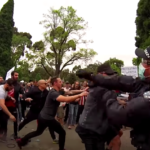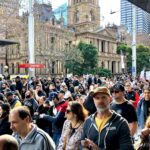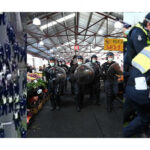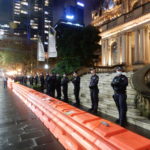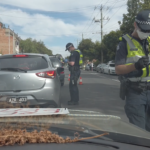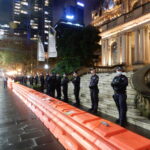Growing Discontent and the Politics of Lockdown
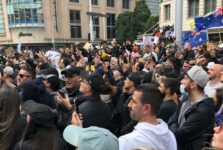
In this country, the supporters of the right side of politics don’t often take to the streets to protest. Most often, that’s the domain of the left.
So, when around 7,000 Sydneysiders breached COVID-19 lockdown restrictions to march through the centre of the CBD fuelled by right-wing rhetoric and waving Aussie flags, it’s a sure sign of widespread community discontent.
The Sydney march was part of a Worldwide Rally for Freedom Day, which was supported by anti-lockdown group Reignite Democracy Australia. So, as elsewhere around the country, the demonstration in Sydney was set to take place prior to onset of the current lockdown.
However, the ranks of the unlawful assembly had swelled way beyond what would have been the case if the Sydney-wide pandemic shutdown wasn’t in place, as there was a strong showing from the city’s southwest, which has been subjected to an intensified lockdown with increased policing.
As they marched through the city, demonstrators were hostile to any mainstream media presence, revealing a growing disbelief amongst certain sectors regarding the official version of the pandemic, which questions the truth of the virus, preventative measures, as well as vaccine and mask use.
And this crowd poses extra issues for Coalition governments as core participants adhere to far-right libertarian outlooks represented by the more extreme members of the Liberal and National parties, meaning too much of a crackdown on restriction breachers could cost votes.
Double standards
The current lockdown of Greater Sydney is moving into its fifth week, with seemingly no end in sight as case numbers continue to grow ever higher. And the recent implementation of pandemic restrictions has resulted in a tale of two cities scenario.
As the initial cluster of COVID cases broke out in Bondi and the surrounding wealthy Eastern Suburbs, fairly laxed lockdown restrictions were applied. However, a week later, when the virus spread out to the less affluent and majority migrant southwestern suburbs, the approach changed.
The Berejiklian government responded by deploying an extra 100 NSW police officers to the area, and, as lockdown rules were made stricter for the entire Greater Sydney region, there were special restrictions on movement that applied only to the outlying multicultural southwest region.
These extra restrictions included workers in the Fairfield, Canterbury-Bankstown and Liverpool local government areas being prevented from travelling outside of the region to work, while those defined as critical and allowed to continue work being placed on a 72 hour testing regime.
The obvious disparities in the response led the communities of the southwest to cry foul. And the crowds that marched along Broadway and up George Street on Saturday had strong and visible representation from the regions that are shouldering the greatest burden.
“Plandemic”
Yet, while the presence of those from the west dealing with extra restrictions was felt, the anti-media sentiment, the refusal of most protesters to wear masks and the anti-vaccine rhetoric all pointed to the dissemination of COVID-19 conspiracy theories amongst the wider public.
The anti-science beliefs that are circling within the community range from the virus being a complete hoax or it being no greater threat than the flu, to governments using the virus as a means to enhance their control of the public via restrictions on movement and enhanced surveillance.
As the overwhelming majority of people on the planet were not alive when lockdown and mask wearing practices were last applied one hundred years ago to deal with the Spanish Flu, it’s no wonder that large numbers have been questioning the extreme preventative measures.
And if those following these theories want validation in more traditional places of authority, they only have to turn on Sky News, which has presenters constantly decrying the lockdown, or look to federal parliament with the likes of George Christensen and Craig Kelly advancing such ideas.
Fend for themselves
Underpinning the rising support for these far-right theories in the Sydney region is the fact that many workers have been left with no support during the current lockdown, which was only supposed to last for two weeks but is now rolling on towards perhaps months.
The nationwide 2020 pandemic lockdowns were supported by the JobKeeper and JobSeeker wage subsidies that, although not perfect, were rolled out to assist employers to continue to pay their employees, as well as fund those who’d lost their jobs.
For the current closedown of Sydney, no such packages have been applied. At the onset, federal treasurer Josh Frydenberg announced that JobKeeper would not be resurrected.
At the commencement of the third week of lockdown, the Morrison government came to the table with a new pandemic financial support scheme, which involves those who have lost up to a day’s weekly work receiving a $375 payment, while those who have lost at least 20 hours receiving $600.
Yet, these payments are hardly adequate to tide over those who have lost a full week’s wage.
This dilemma highlights the problematic aspect of the heavy reliance on casual work our economy has developed, which leaves employees with nothing to fall back on in times of crises.
Trumpism down under
The most disturbing aspect to Saturday’s anti-lockdown freedom march, however, is the fact that it shows the same far-right lines of thought that are present in the US have taken root here. These are the same ideologies that fuel the beliefs of grassroots Trump supporters.
Obvious comparisons were drawn between the violent clashes involving NSW police officers and anti-lockdown protesters in front of Sydney Town Hall on 24 July, and the scenes of Trump supporters storming Washington’s Capitol Building on 6 January.
In the States, these conspiracy theories are for the most part the domain of far-right white supremacists, and their spread within the Australian community is most likely to prop up a further rise in the grassroots nationalist and neo-Nazi groups that are already growing in the suburbs.
The extremes of the pandemic, it seems, are only resulting in an increase in the numbers of extremists who serve as fodder for such groups, and with more climate-driven crises potentially on the way, these fringe forces are likely to become more mainstream.


